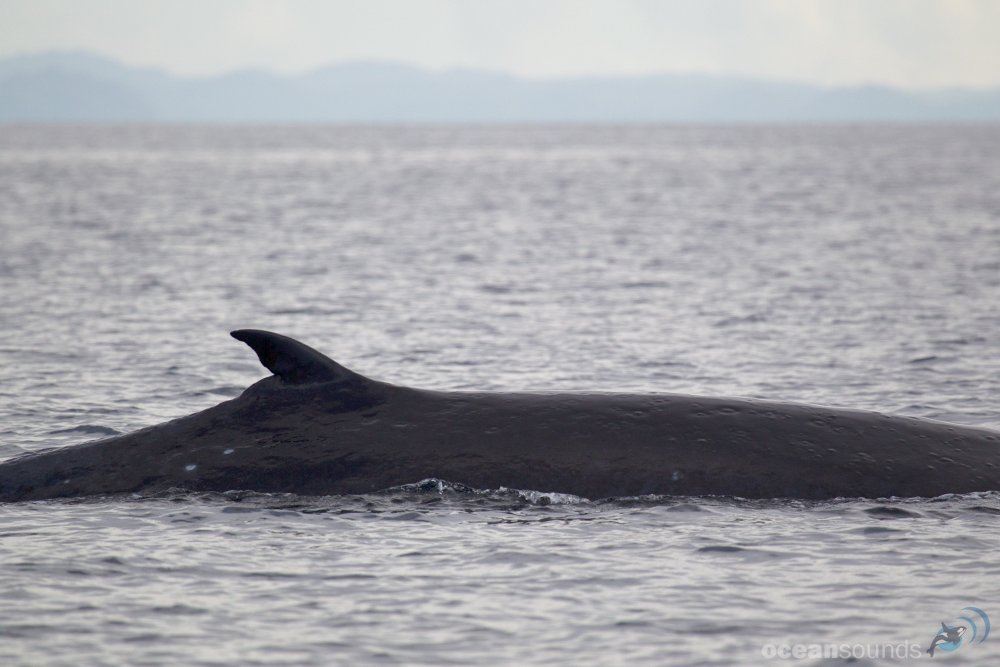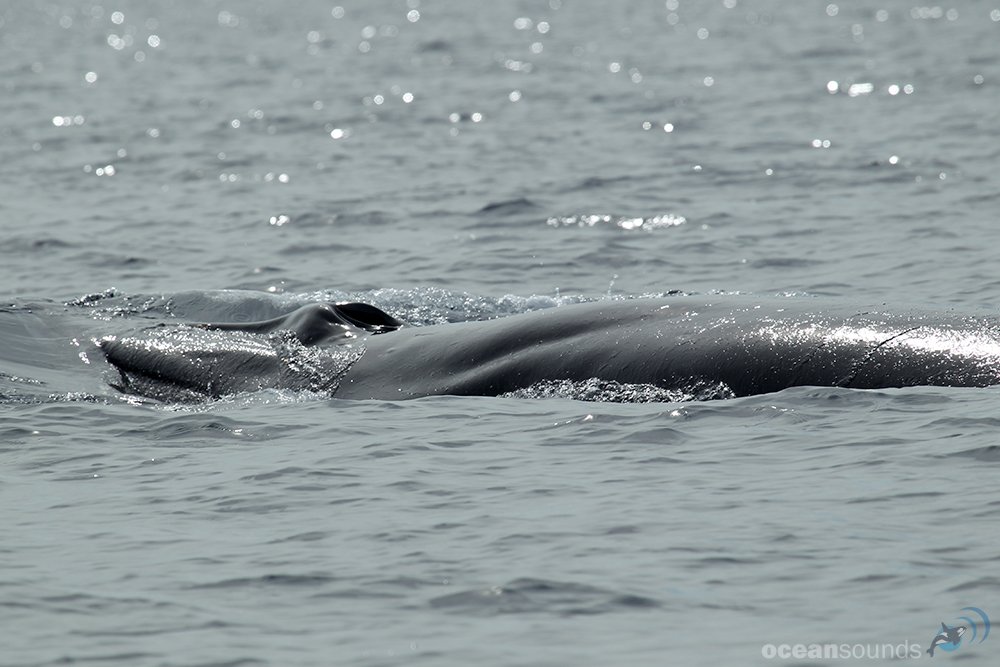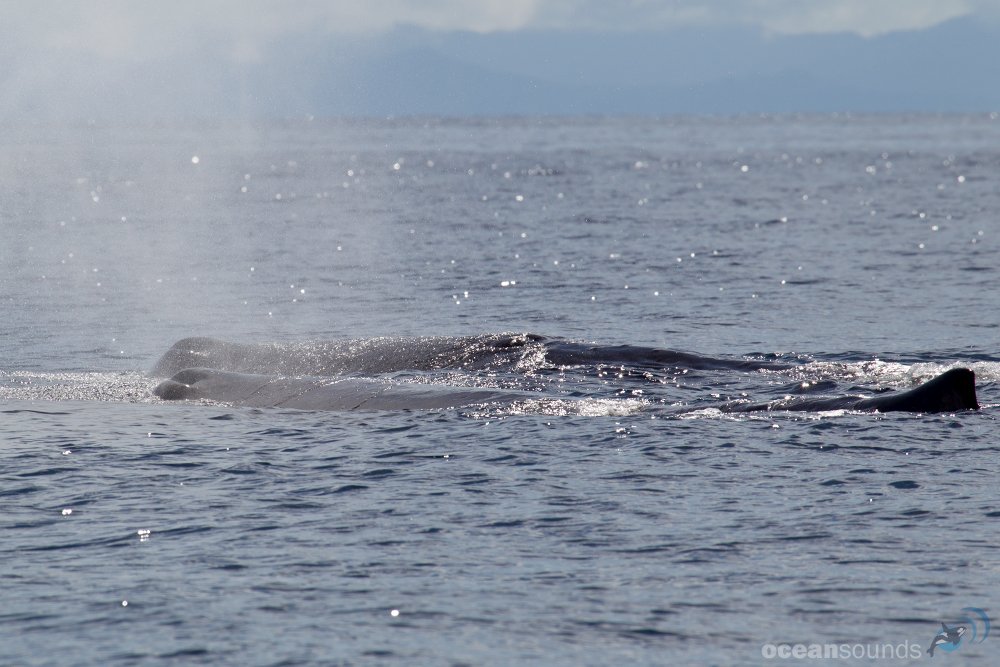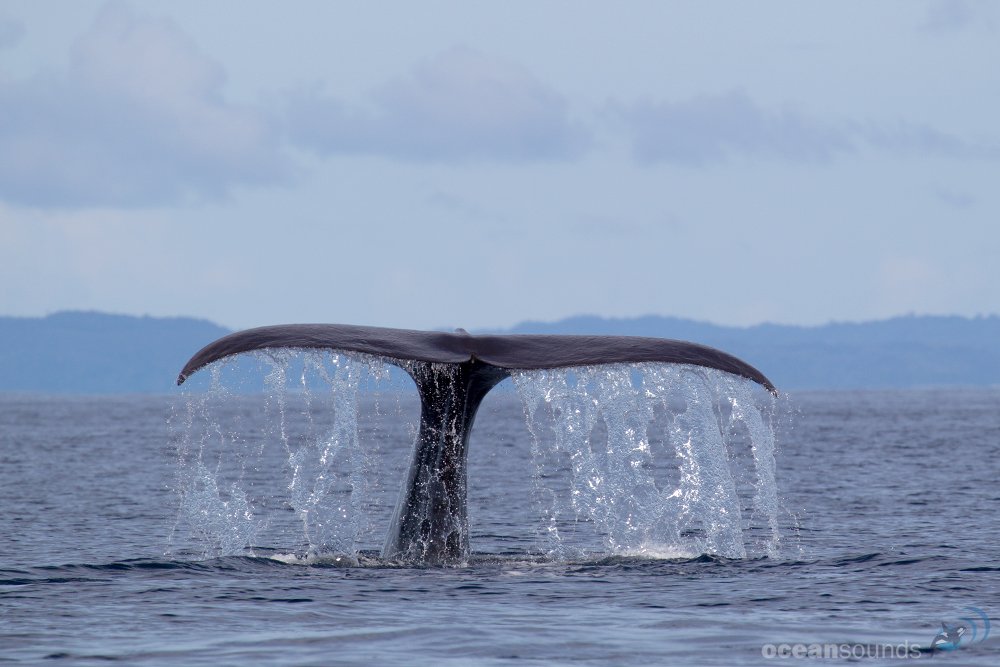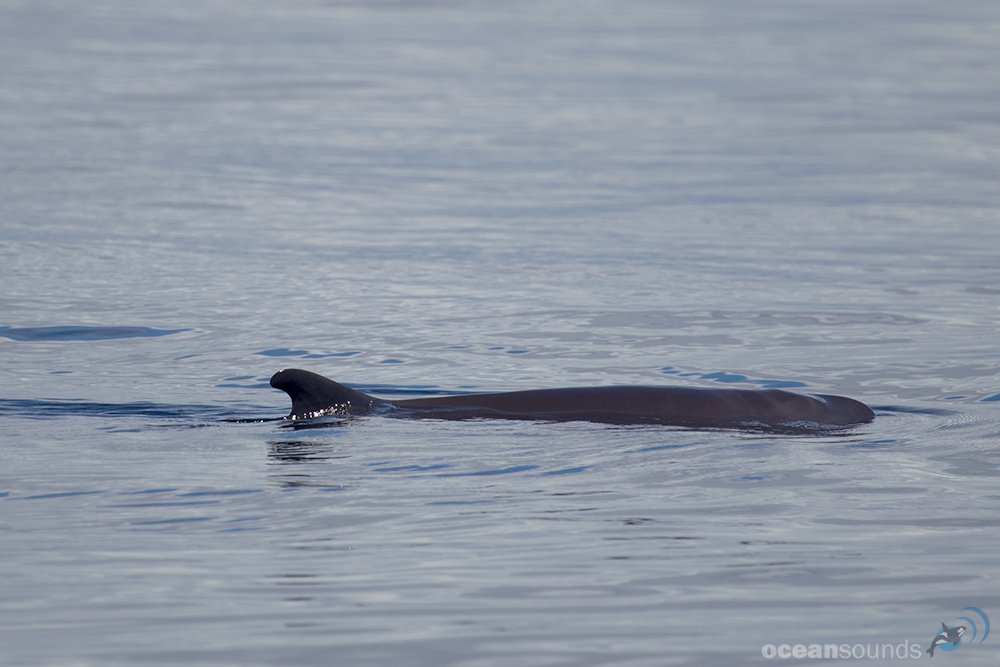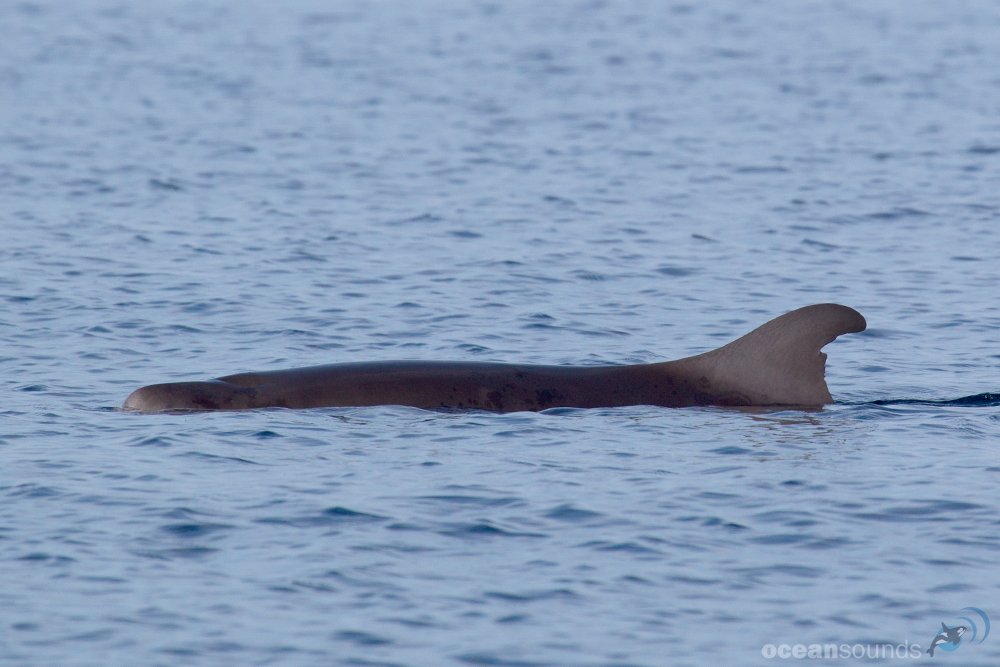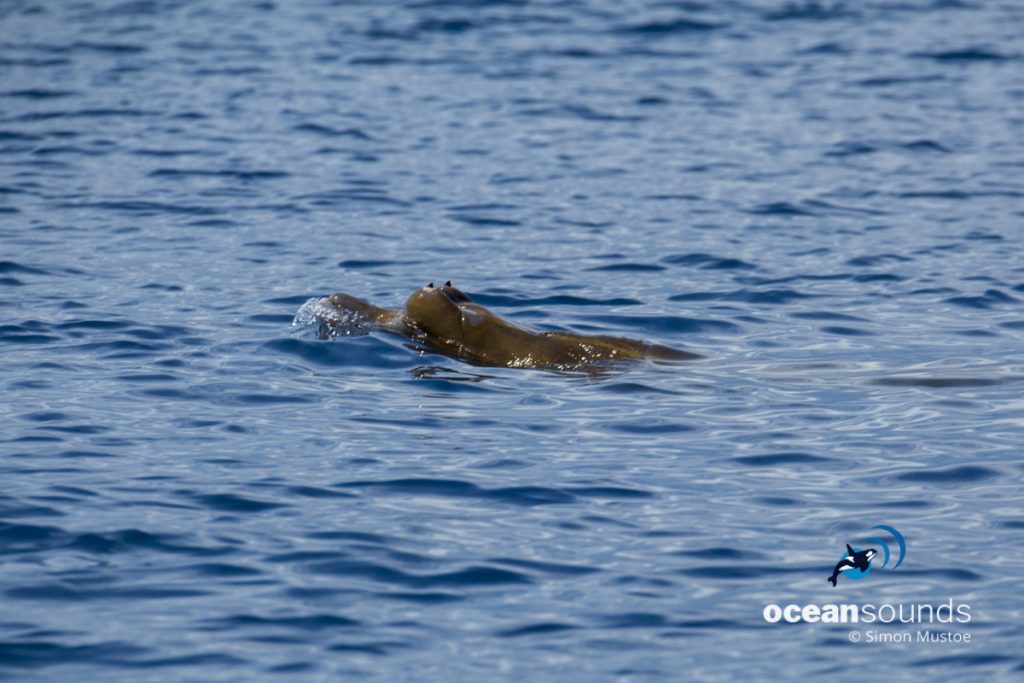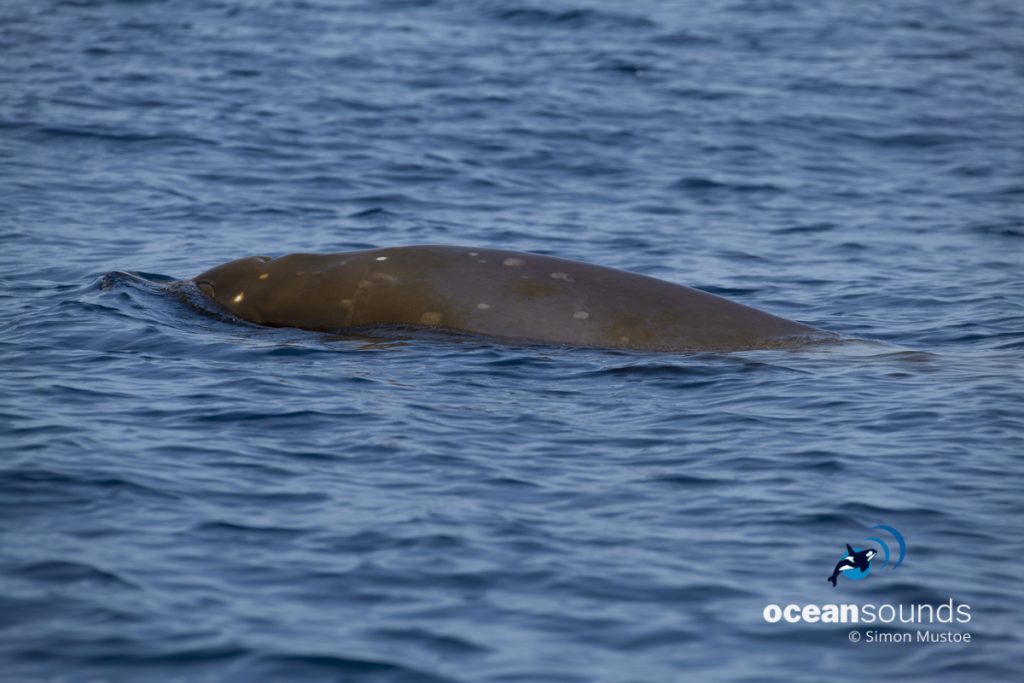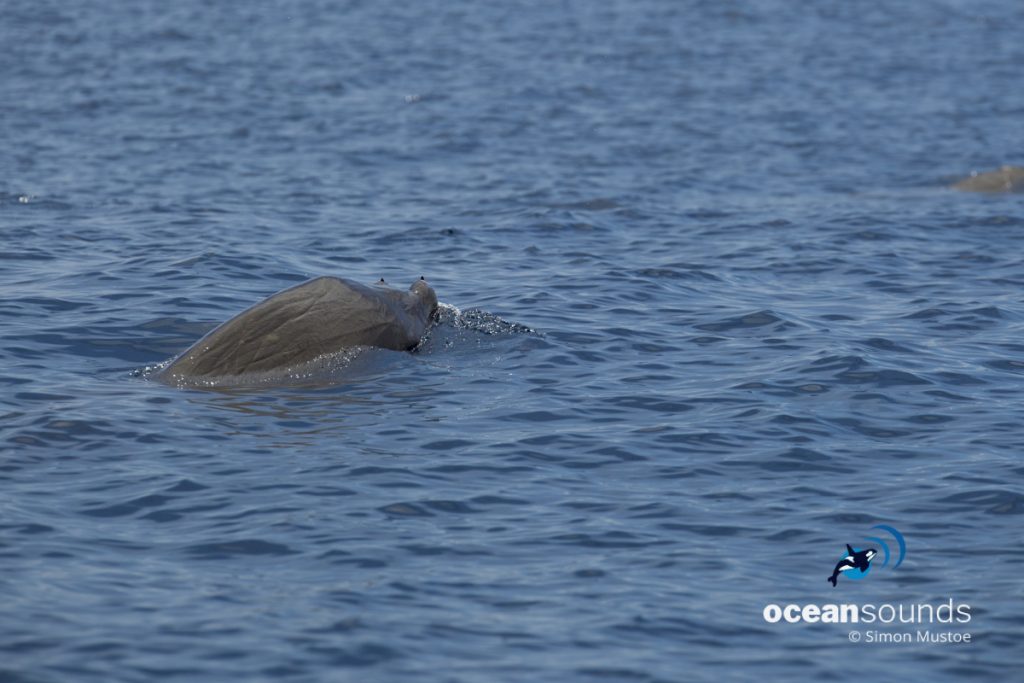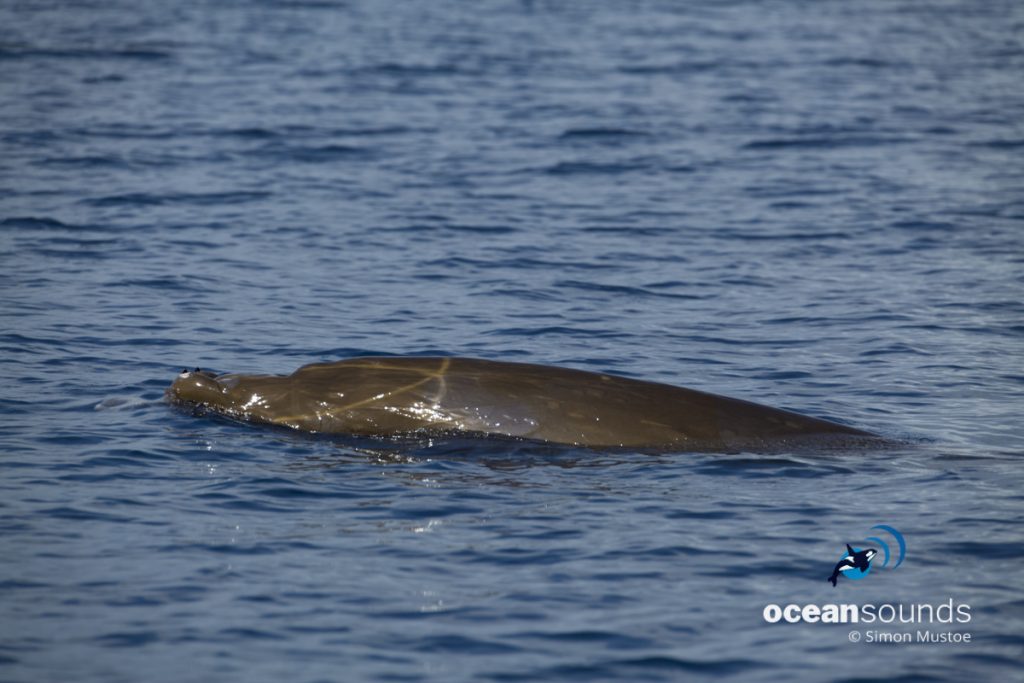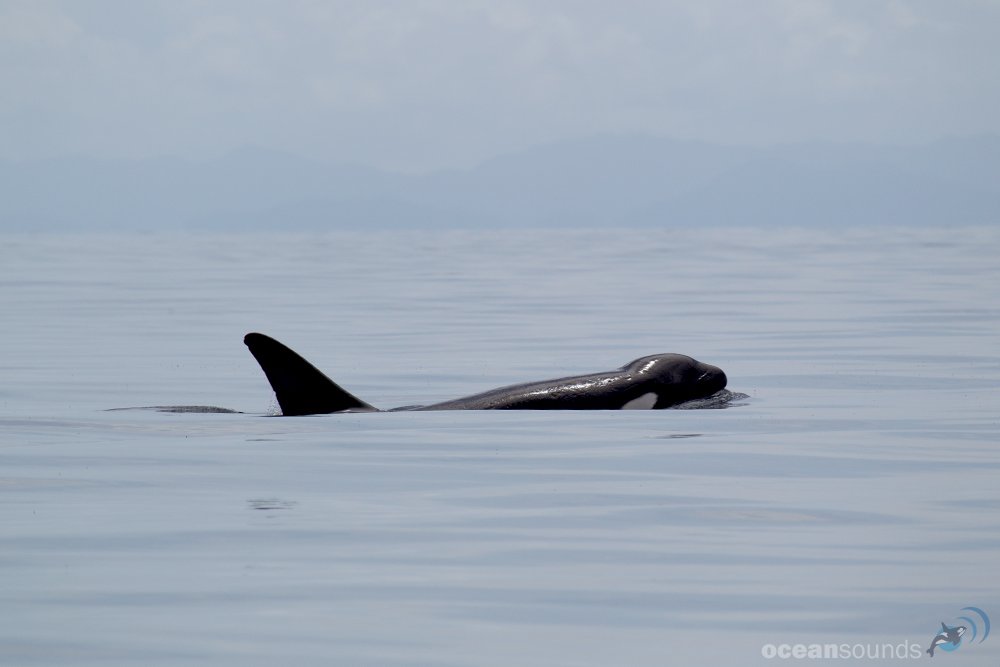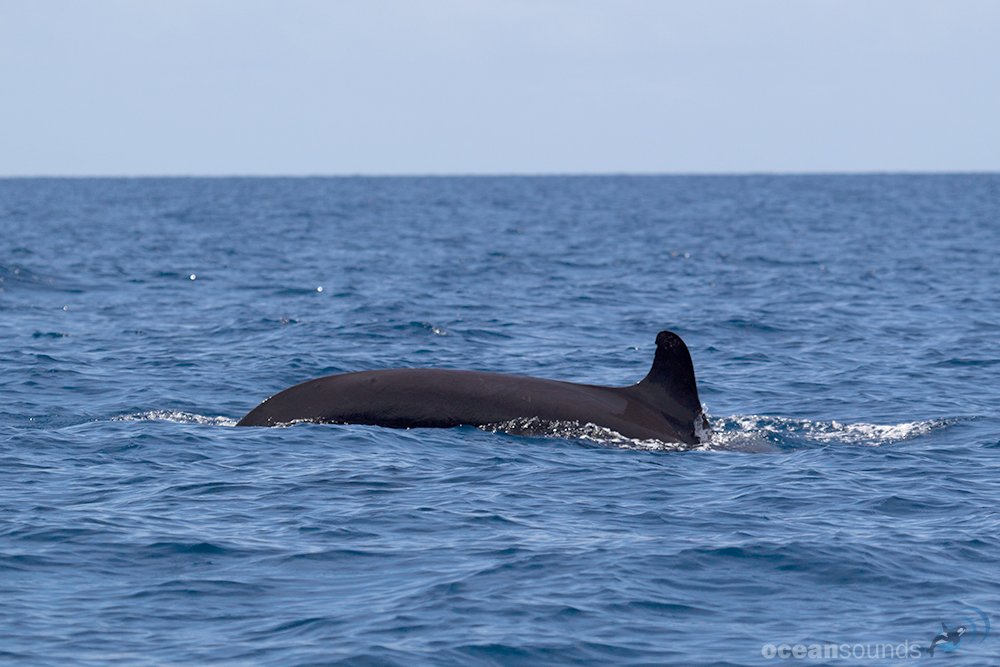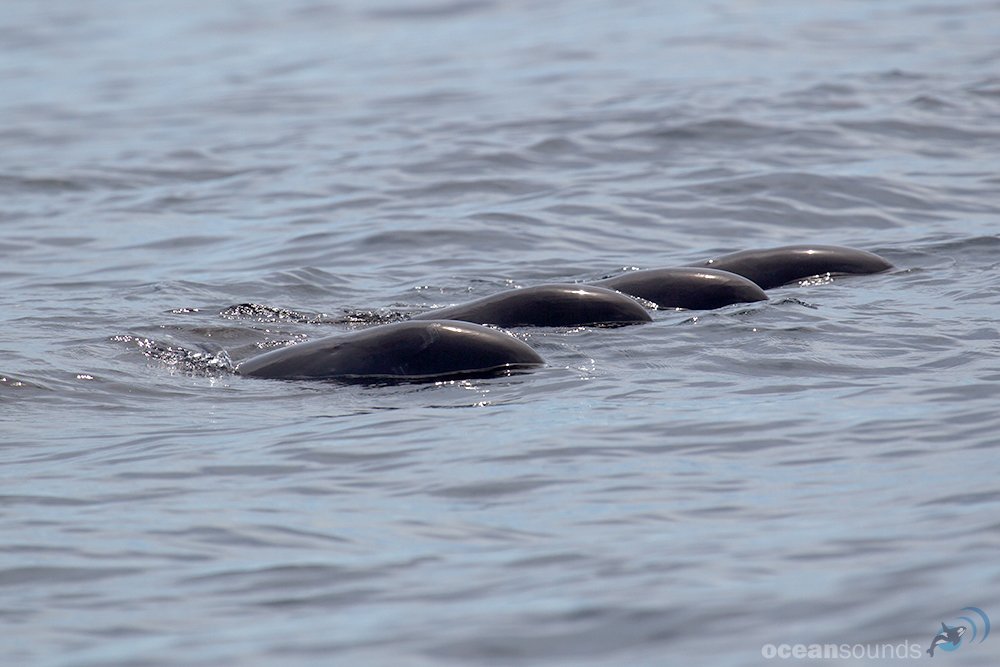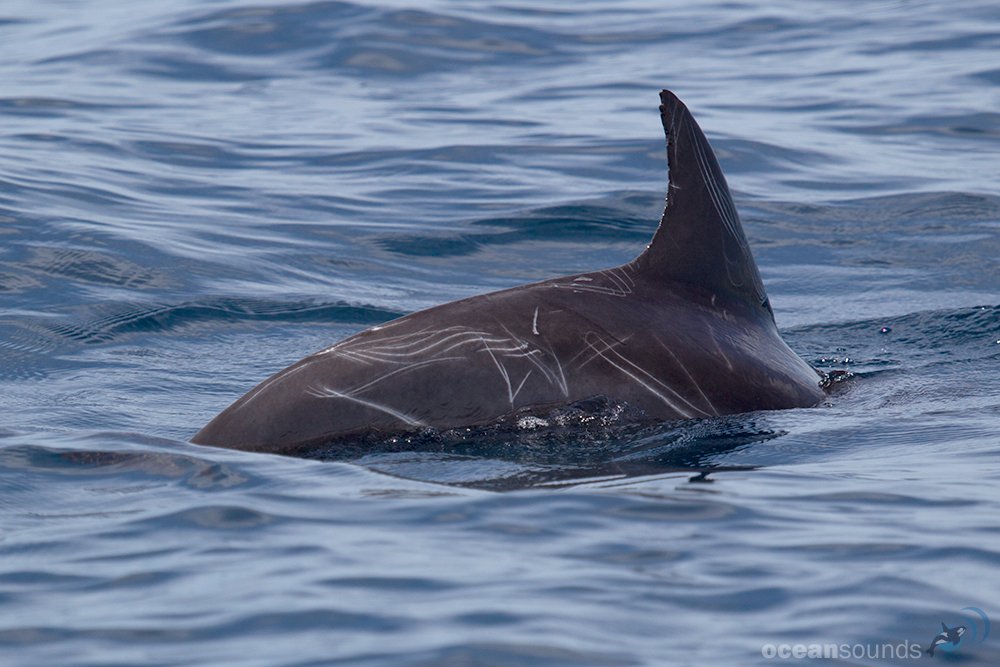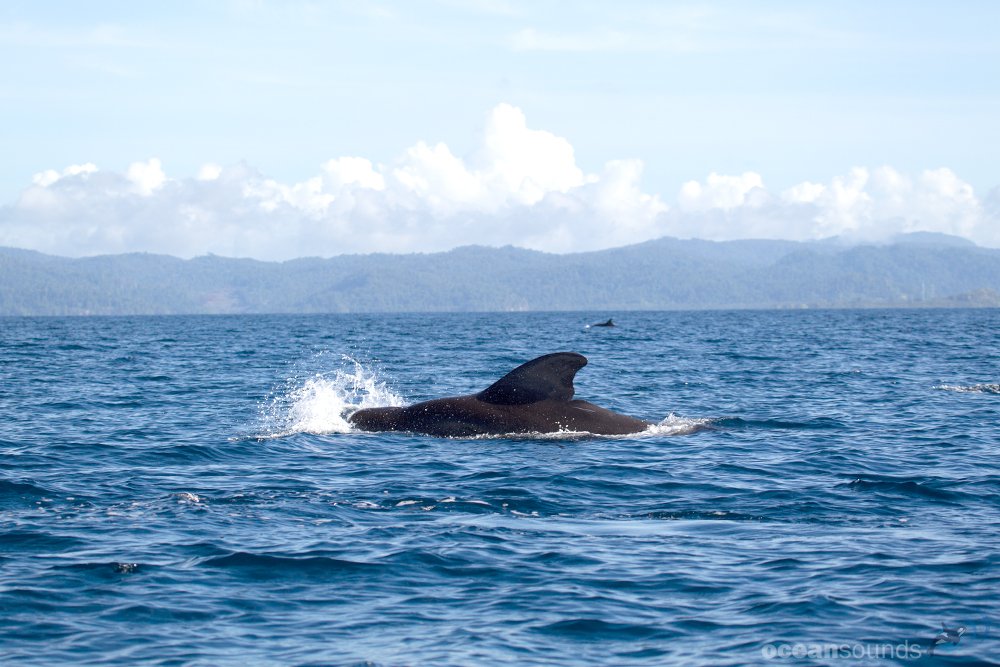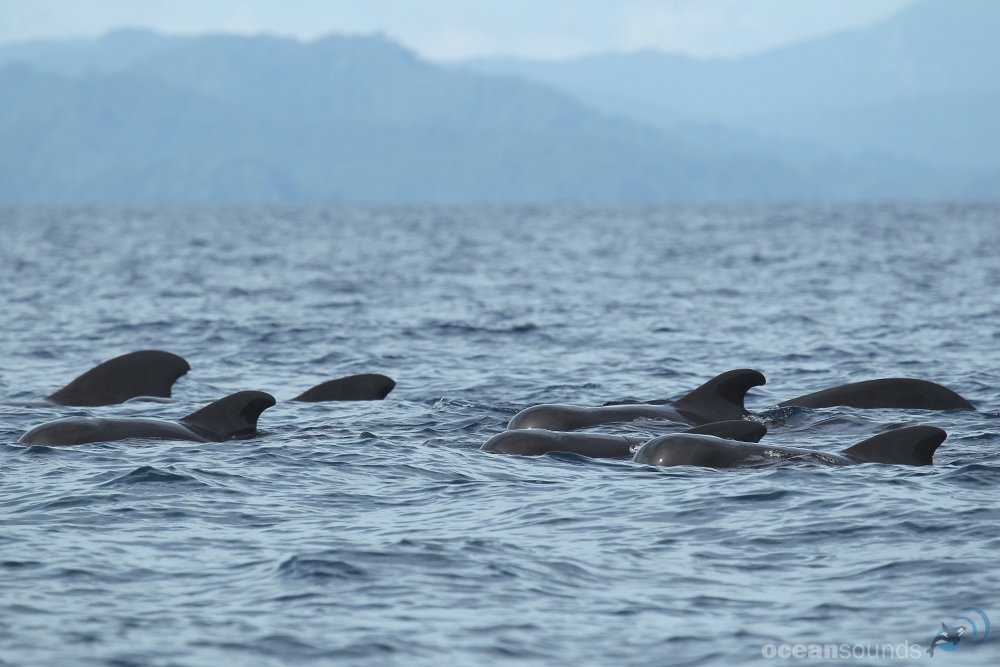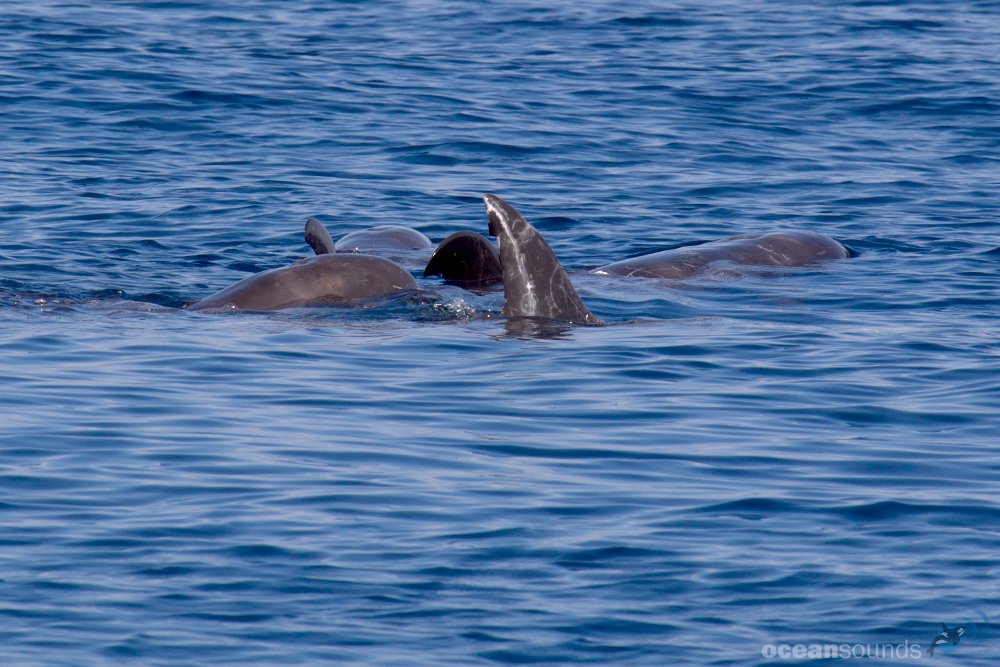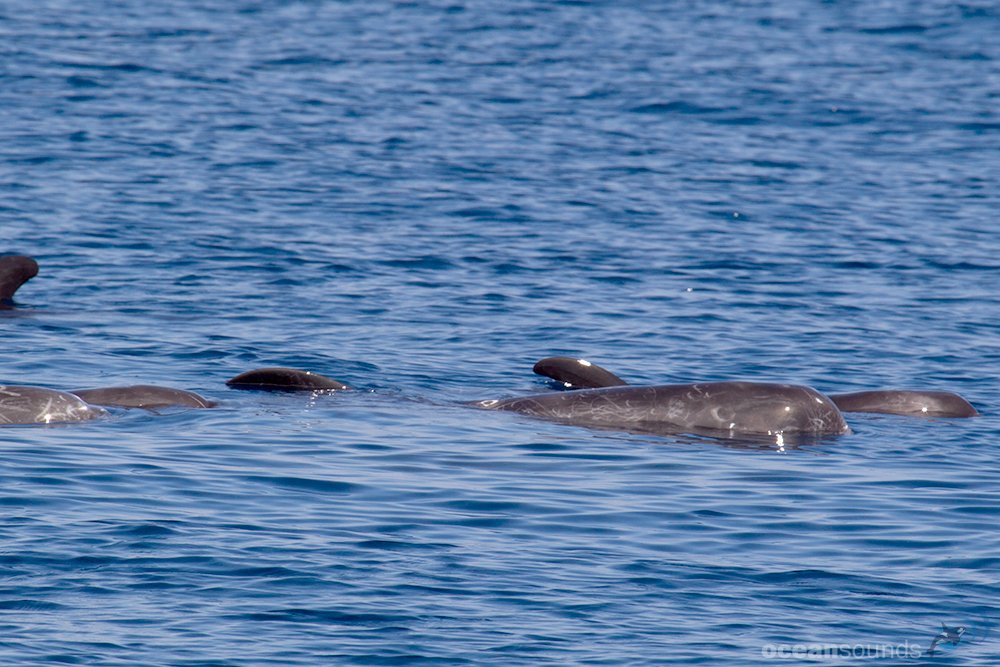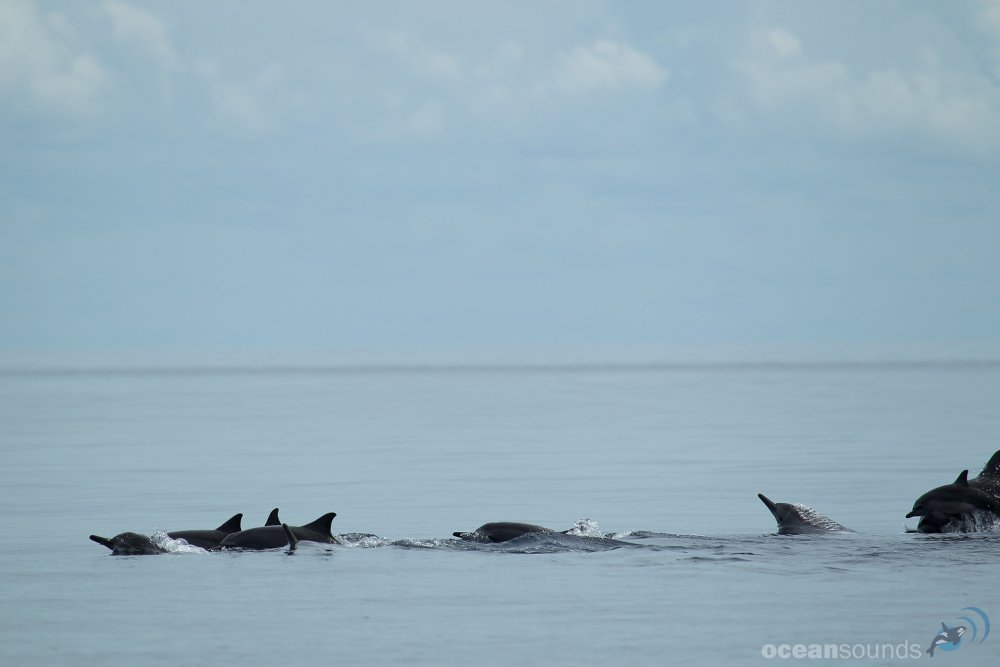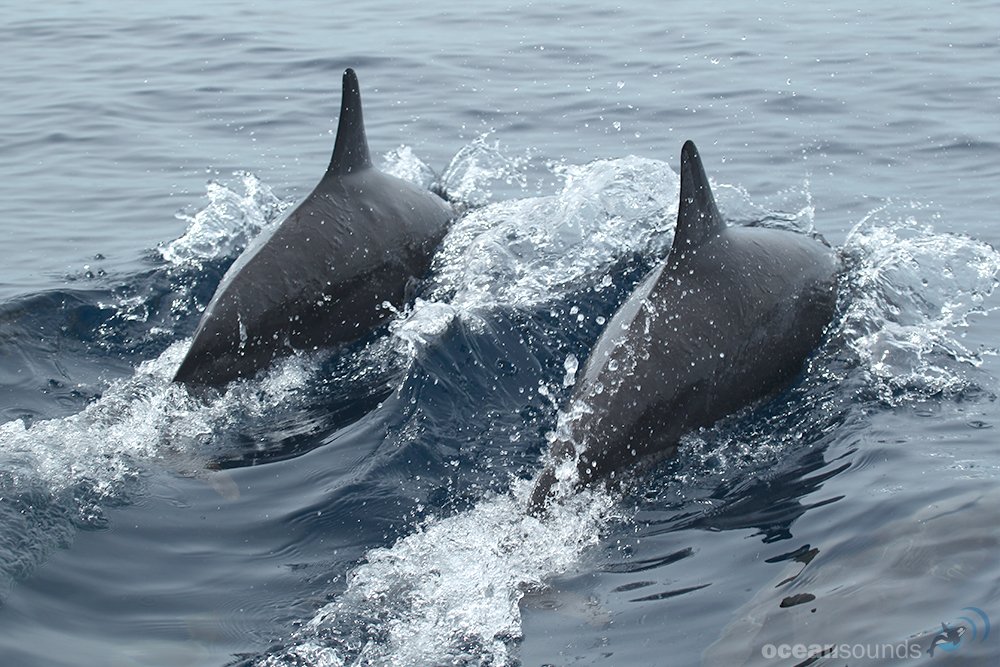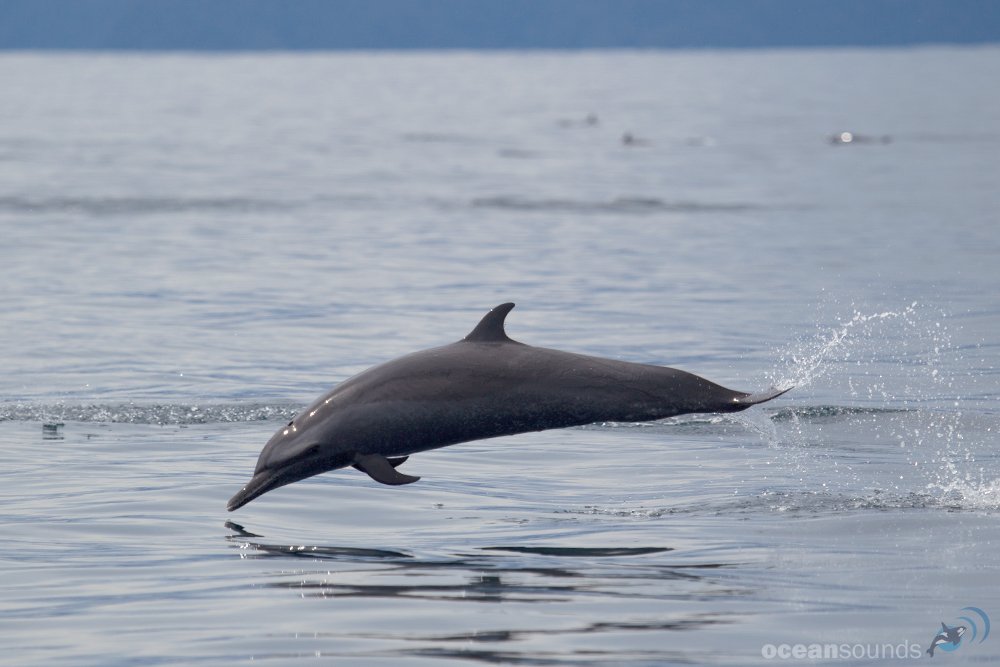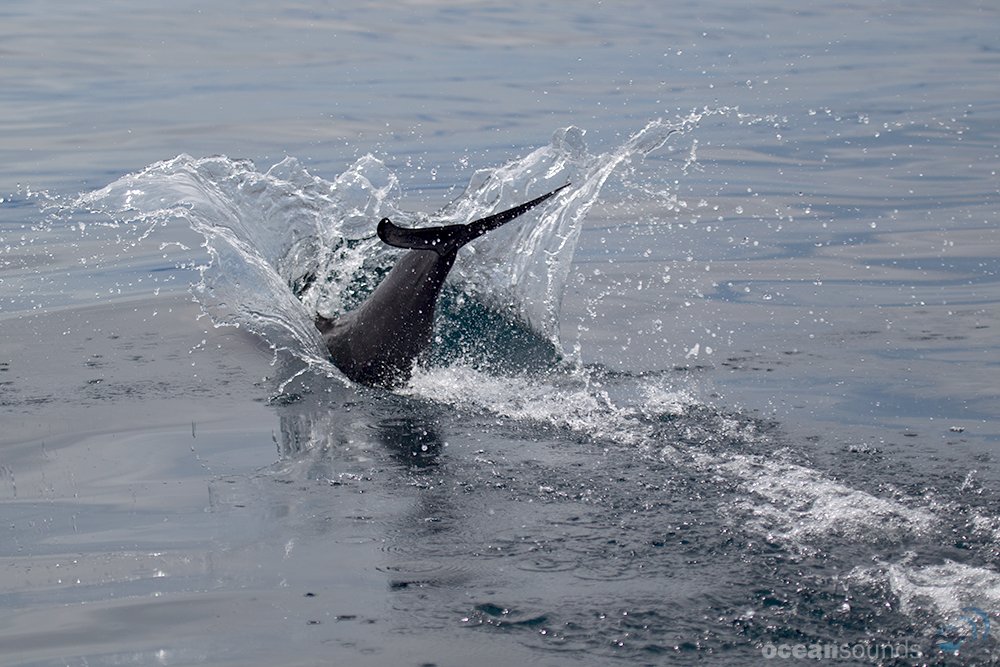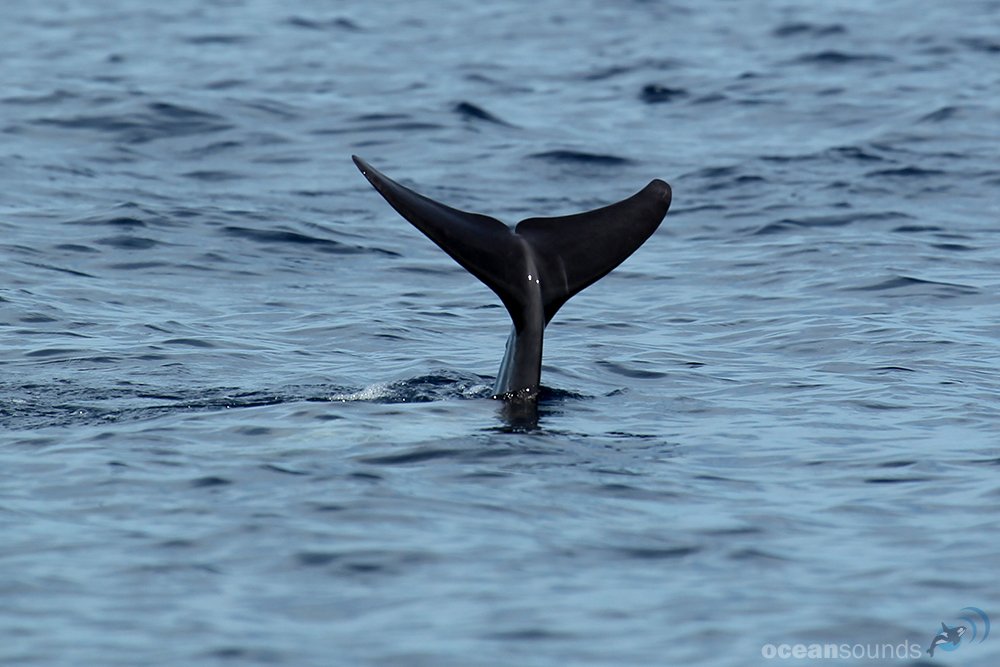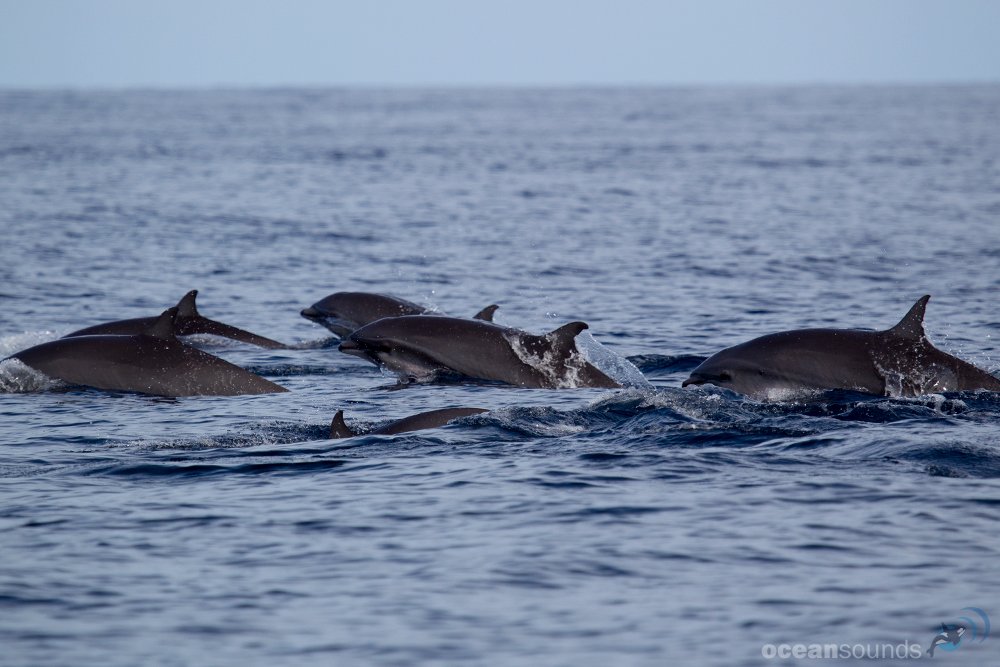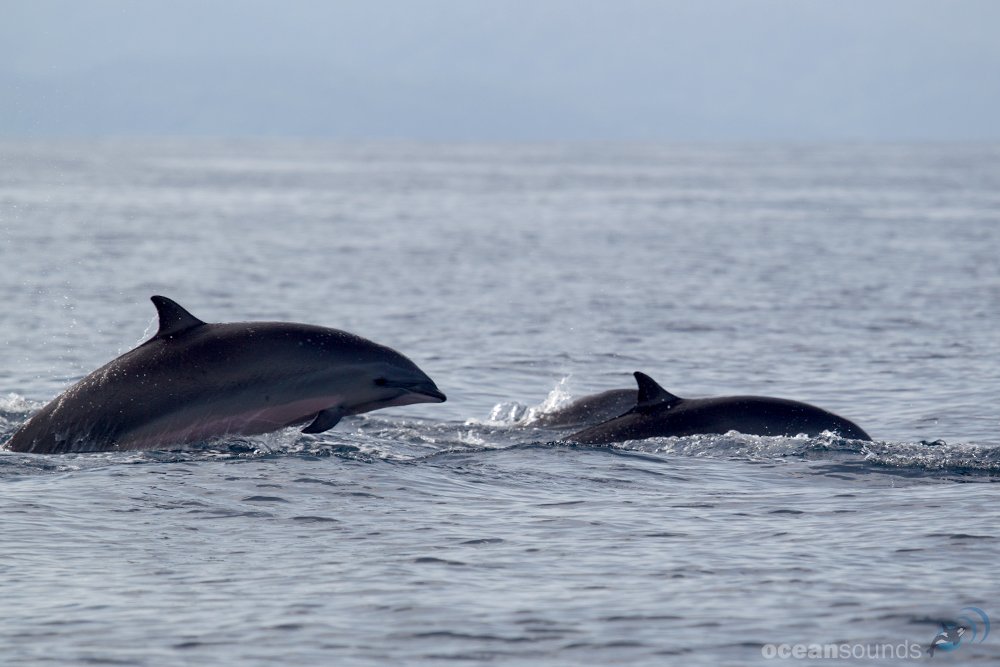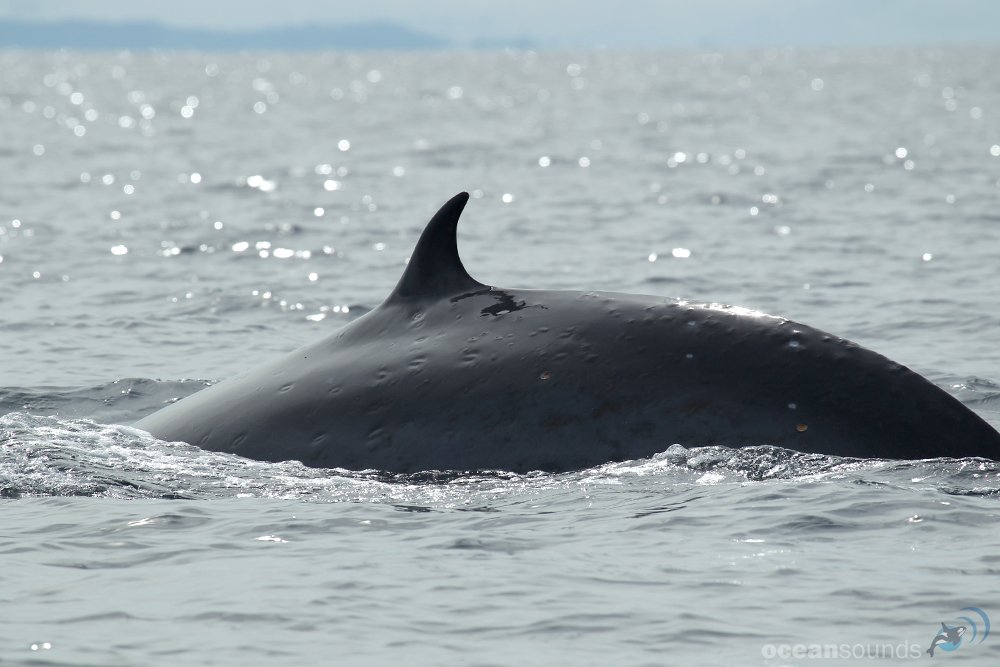
Bryde’s Whale
Balaenoptera edeni
Raja Ampat: might be a local population but this is not confirmed yet.
Group formation: Solitary (mother-calf pair or larger feeding groups up to 20)
Size: males 12-15 m, females 12-16 m, calf 4 m
Weight: ca. 40 t, calf 1 t
Spout: 3-4 m
Age: 40-70 yrs
Sexual maturity: 8-11 yrs
Gestation: 11-12 mths, with 2 yrs in between
Weaning: 6-7 months
Diet: Fish, planktonic crustaceans, and cephalopods.
Predators: killer whales, sharks, especially cookie cutter sharks.
Distribution: Worldwide within highly productive tropical, subtropical and warm temperate waters in all oceans from 40° South to 40° North, they do not migrate.
Population size: global ca. 90.000 – 100.000
Conservation Status: Data Deficient ver 3.1, Pop. trend: unknown
Threats: Vessel collisions, whaling (Japan, Indonesia, Philippines), chemical and plastic pollution, man-made noise impacts (seismic surveys, military sonar), entanglement in fishing gear, over fishing.
Sperm whale
Physeter macrocephalus
Raja Ampat: breeding and feeding area for females and calves, matrilines, possibly stable all year round – males arrive for breeding, migration routes are unknown.
Group formation: Matrilineal groups (<12), male bachelor groups/solitary males
Size: males 15-18 m, females 11 m, calf 4 m
Weight: males 40-50 t, females 14 t, calf 1t
Spout: 2 m at 45° angle, second deepest diver 90 min 2200 m
Age: >80 yrs
Sexual maturity: males 18 yrs, females 9-13 yrs
Physical maturity: males 50 yrs
Gestation: 14-16 mths, 4-20 yrs in between
Weaning: 19-42 mths
Diet: mostly squid, octopuses, some fish
Distribution: Cosmopolitan, prefers ice free waters deeper than 1000m, continental shelf or canyons
Population size: unknown, heavily exploited (67% reduced)
Conservation Status: Vulnerable A1d ver 3.1, Pop. trend: unknown
Threats: Vessel collisions, whaling (Japan, Indonesia), plastic pollution, man-made noise impacts (seismic surveys, military sonar), entanglement in fishing gear, over fishing
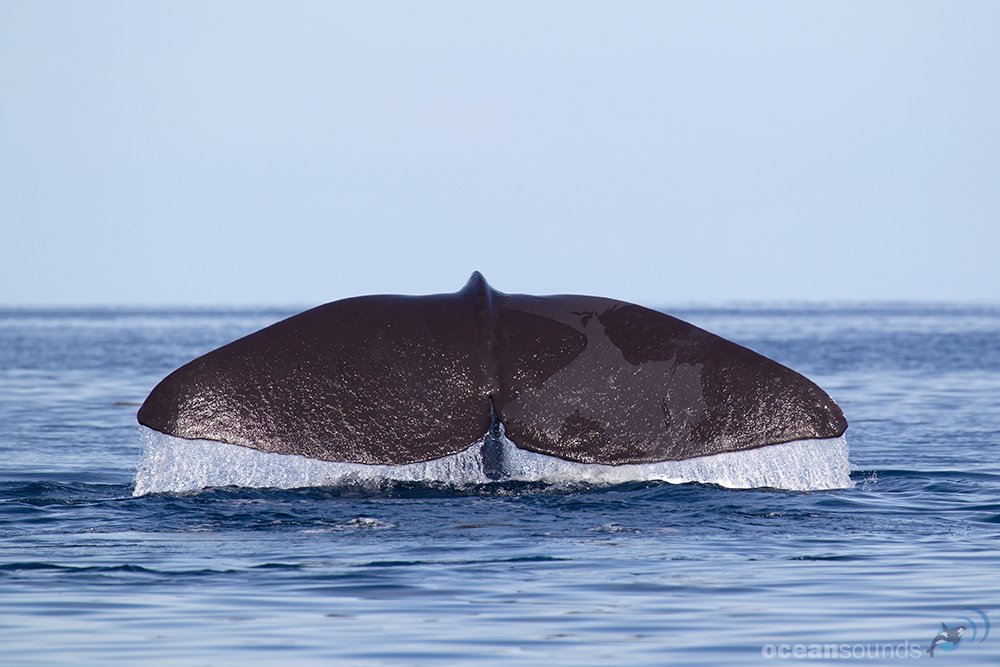
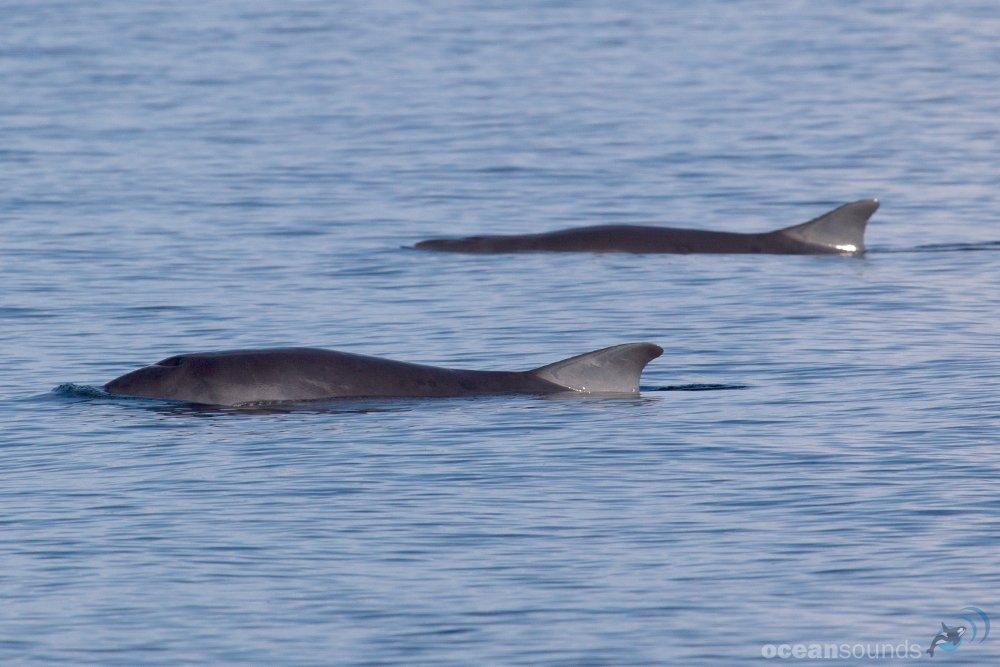
Pygmy sperm whale
Kogia breviceps
Raja Ampat: might be a local population but this is not confirmed yet.
Group formation: Solitary or in pairs or up 6
Size: 3.5 m, calf 1.2 m
Weight: 400 kg, calf 50 kg
Age: 23-? yrs
Sexual maturity: 4-5 yrs
Gestation: 11mths, with 1-2 yrs in between
Weaning: 1 yr
Diet: squid (cephalopods)
Predators: killer whales, sharks – eject over 12 liters of viscous, dark reddish-brown liquid when they feel threatened or when trying to evade predators.
Distribution: tropical and temperate waters of the Atlantic, Pacific and Indian Oceans, in waters ranging from 400 to 1,000m.
Population size: unknown
Conservation Status: Data Deficient ver 3.1, Pop. trend: unknown
Threats: Vessel collisions, whaling (Japan, Indonesia), chemical and plastic pollution, man-made noise impacts (seismic surveys, military sonar), entanglement in fishing gear, over fishing, die in captivity.
Blainville’s Beaked Whale
Mesoplodon densirostris
Raja Ampat: might be a local population but this is not confirmed yet. There is one sighting (2020) and one live stranding (2018).
Group formation: Small groups (mother-calf pair or groups of 3-7 with lead male)
Size: 4.3 – 4.8m
Weight: ca. 1 t
Spout: Inconspicuous
Age: 23+ years
Sexual maturity: 8-11 yrs
Gestation: 12 mths, with 3-4 yrs in between
Weaning: 12 months
Diet: Deepwater squid and fish.
Predators: killer whales, sharks, especially cookie cutter sharks.
Distribution: Worldwide tropical to warm temperate waters.
Population size: Unknown
Conservation Status: Data Deficient ver 3.1, Pop. trend: unknown
Threats: Chemical and plastic pollution, man-made noise impacts (seismic surveys, military sonar).
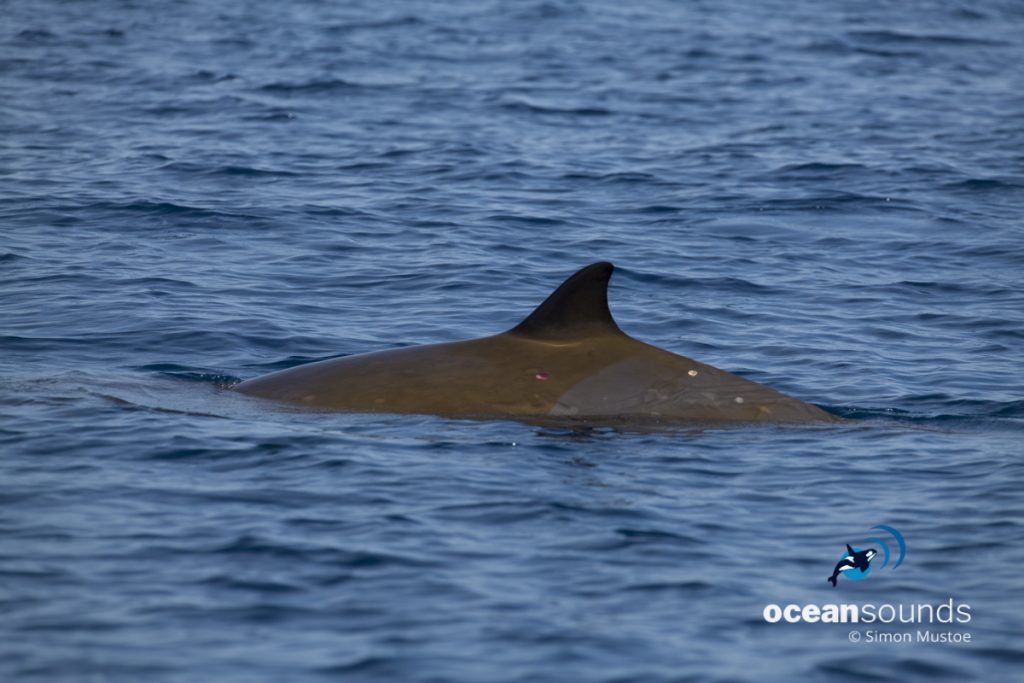
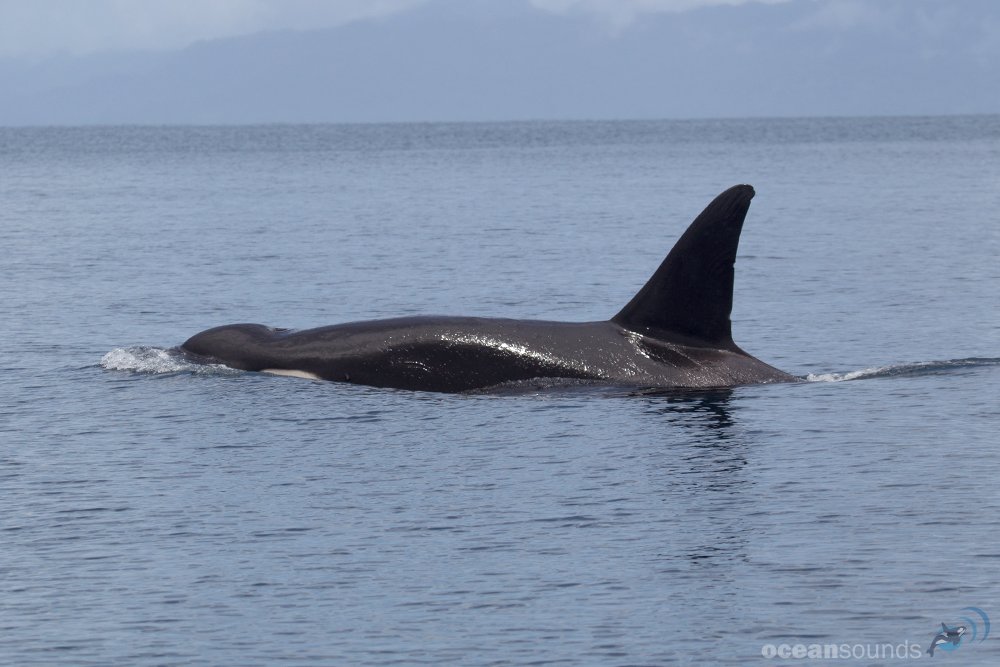
Killer Whales or Orca
Orcinus orca
Raja Ampat: Orcas are distribution all along the coast, but low in numbers, can be seen solitary or in small groups.
Group formation: Matrifocal groups (size 3-10)
Size: males 6-10m, females 5-8m, calf 2.2m
Weight: males 5-6tons, females 3-4tons, calf 180kg
Age: males 30 (60)yrs, females 50 (80-103)yrs
Sexual maturity: males 15-20 yrs, females 15 yrs
Physical maturity: males 20-25 yrs, females 15 yrs
Gestation: 16-17mths, birth every 3-4 yrs, menopause around 40yrs of age
Diet: Marine mammals mostly dolphins, manta rays
Distribution: Toothed whale, largest dolphin, distributed all over the world.
Population: min. 50 000
Conservation Status: Data Deficient ver 3.1, Pop. trend: unknown
Threats: whaling (Indonesia, Greenland), plastic pollution, man-made noise impacts (seismic surveys, military sonar), entanglement in fishing gear, over fishing, captivity.
Cooperation: Georgina Gemmell, Lead Administrator, Orca Project Sri Lanka
False killer whale
Pseudorca crassidens
Raja Ampat: they have been sighted regularly but nothing is known about them.
Group formation: Social groups 20-30 (over 100)
Size: males 6 m, females 5 m, calf 2 m
Weight: males 2200 kg, females 1200 kg, calf unknown
Age: 63 yrs
Sexual maturity: 12 yrs
Gestation: 14-16mths, with 7 yrs in between
Weaning: 1.5-2.5 yrs
Diet: mostly fish (e.g. tuna, sailfish) and squid (cephalopods), but do attack small cetaceans, humpback whales, and sperm whales.
Distribution: Oceanic dolphin family (Delphinidae) that lives in tropical and semitropical oceanic deep (>1000m) waters throughout the world. Common habitat is the open ocean, but they travel through more coastal areas as well.
Population size: ca. 60.000, eastern tropical Pacific 39.800.
Conservation Status: Data Deficient ver 3.1, Pop. trend: unknown
Threats: Whaling (Japan, Indonesia, West Indies), chemical and plastic pollution, man-made noise impacts (seismic surveys, military sonar), entanglement in fishing gear, over fishing, captivity.
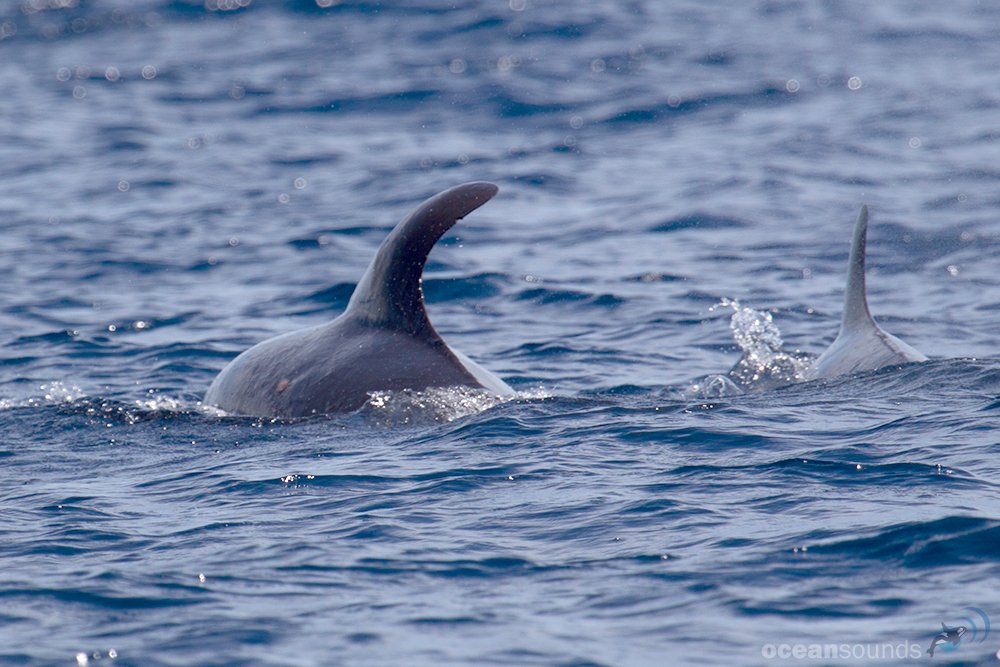
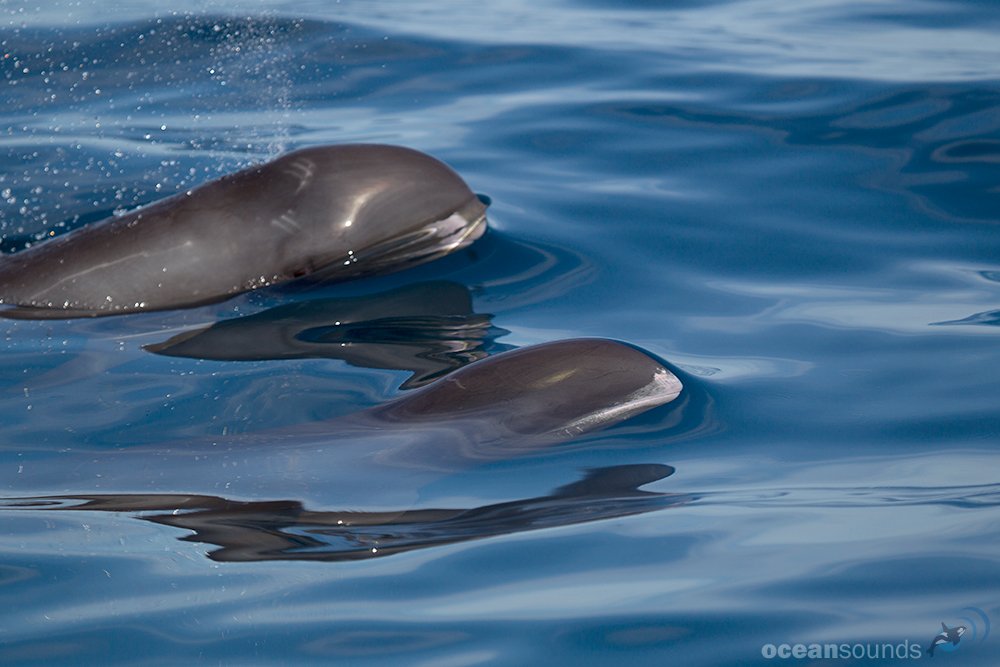
Pygmy killer whale
Feresa attenuata
Raja Ampat: they have been sighted but nothing is known about them.
Group formation: Social groups 12-50 (>100)
Size: males 2.6 m, females 2.5 m, calf 0.8 m
Weight: 110-170 kg, calf unknown
Age: unknown
Sexual maturity: unknown
Gestation: unknown
Weaning: unknown
Diet: mostly fish (e.g. tuna) and squid (cephalopods), and smaller dolphins.
Distribution: rarely seen, from oceanic dolphin family (Delphinidae) that lives in tropical and semitropical oceanic deep (>1000m) waters throughout the world.
Population size: ca. 40.000, eastern tropical Pacific 39.800.
Conservation Status: Data Deficient ver 3.1, Pop. trend: unknown
Threats: Whaling (Japan, Indonesia, West Indies, Sri Lanka), chemical and plastic pollution, man-made noise impacts (seismic surveys, military sonar), entanglement in fishing gear, over fishing, captivity (aggressive).
Short-finned pilot whale
Globicephala macrorhynchus
Raja Ampat: they have been sighted regularly in large groups (>100), but nothing is known about them.
Group formation: Social groups (matrifocal and matrilineal groups) 5-15 (> 200)
Size: males 5.5 m, females 3.7 m, calf 1.4 m
Weight: males 3000 kg, females 1200 kg, calf 102 kg
Age: males 40 yrs, females 65 yrs
Sexual maturity: 10 yrs
Gestation: 12-15 mths, with 5-8 yrs in between
Weaning: 2-5 yrs (up to 15 yrs) menopause with 40 yrs
Diet: mostly squid, octopus, sometimes fish.
Distribution: Belongs to the oceanic dolphin family (Delphinidae) that lives in tropical and semitropical oceanic deep (>1000 m) waters throughout the world, range between 50° N and 40° S.
Population size: unknown
Conservation Status: Data Deficient ver 3.1, Pop. trend: unknown
Threats: Whaling (Japan, Indonesia, Sri Lanka, West Indies), chemical and plastic pollution, man-made noise impacts (seismic surveys, military sonar), entanglement in fishing gear, over fishing, captivity.
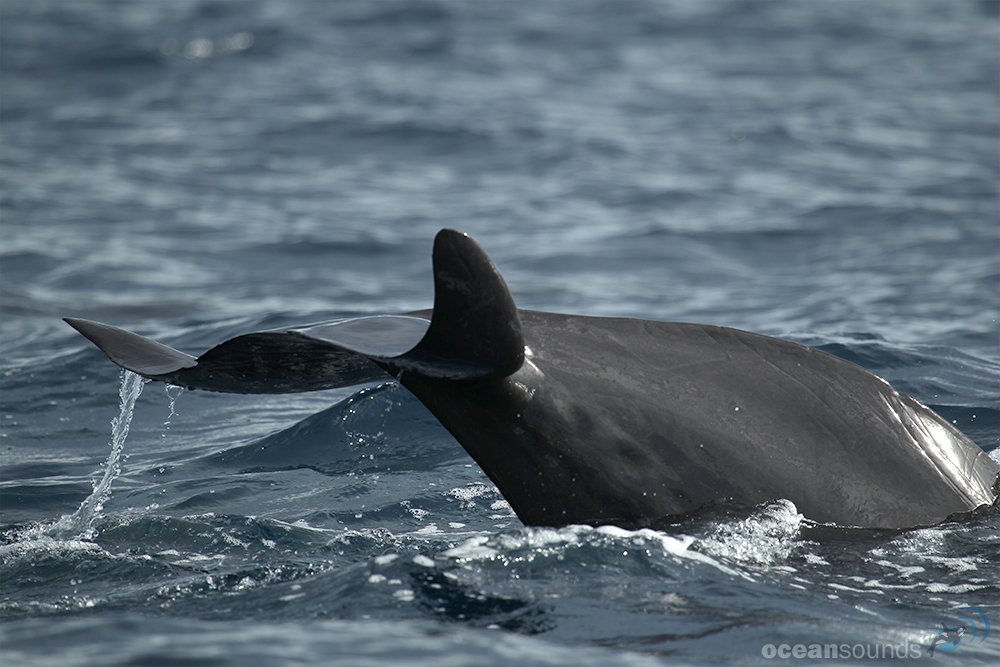
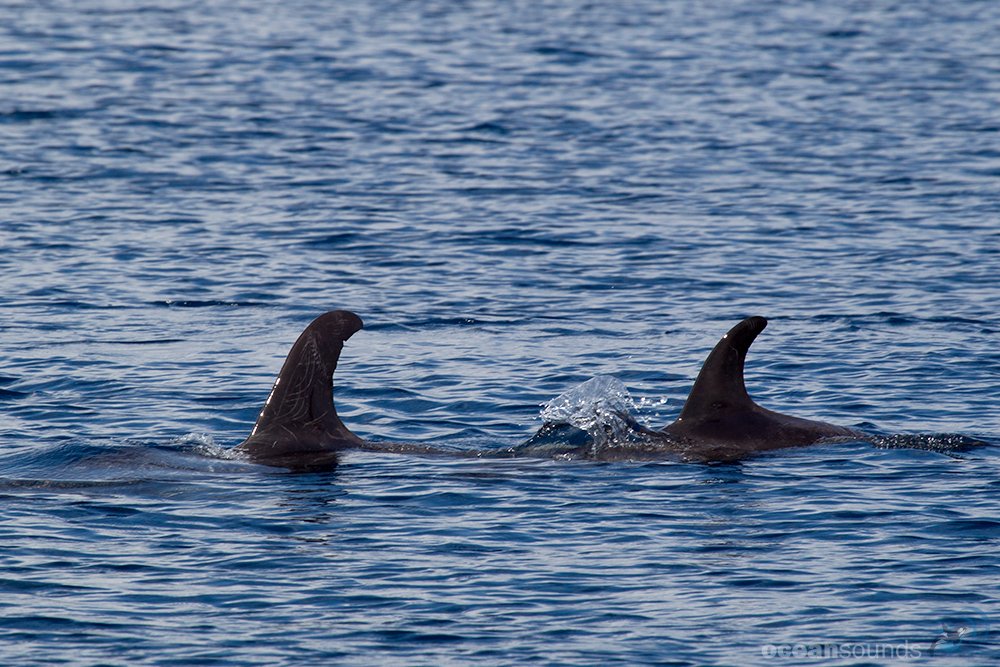
Risso’s dolphin
Phocoena phocoena
Raja Ampat: they have been sighted rarely in small groups (25), but nothing is known about them.
Group formation: Social groups 5-50
Size: 2.6-4 m (male and female same size), calf 1.1-1.7 m
Weight: 300-500 kg, calf 20 kg
Age: 40 yrs
Sexual maturity: males 10-12 yrs, females 8-10 yrs
Gestation: 13-14 mths, with 2-4 yrs in between
Weaning: unknown (probably 1-3 yrs)
Diet: mostly squid, nocturnal feeders.
Distribution: Cosmopolitan species that lives in deep water preferably close to continental shelves, close to land (400-1000m) prefer temperate, subtropical and tropical waters but the range is 60° N to 60° S.
Population size: unknown
Conservation Status Least Concern ver 3.1, Pop. trend: unknown
Threats: Whaling (Faeroe Islands, Japan, Sri Lanka, Indonesia, West Indies), chemical and plastic pollution, man-made noise impacts (seismic surveys, military sonar), entanglement in fishing gear, over fishing, captivity.
Long-beaked spinner dolphin
Stenella longirostris
Raja Ampat: they are very common and often sighted in large groups of 100 or more
Group formation: Social fission fusion groups 25-300
Size: 129–235 cm, calf 0.75 m
Weight: 23–79 kg, calf unknown
Age: 20 yrs
Sexual maturity: males 7-10 yrs, females 4-7 yrs
Gestation: 10 mths, 3 yrs in between
Weaning: 1-2 yrs
Diet: they feed mostly at night on mid-water fishes and deep-water squid, such as small mesopelagic fish, squids, shrimps, for which they will dive 200–300 m and then rest for most of the daylight hours
Predators: sharks, killer whales, false killer whales, pygmy killer whales, short-finned pilot whales
Distribution: lives in all tropical and subtropical waters between 40° N and 40° S, with 4 sub species
Population size: > 1 million
Conservation Status: Data Deficient ver 3.1,Pop. trend: unknown
Threats: Whaling (Japan, Sri Lanka, Indonesia), chemical and plastic pollution, man-made noise impacts (seismic surveys, military sonar), entanglement in fishing gear, as bycatch in yellow tuna fisheries, over fishing, captivity.
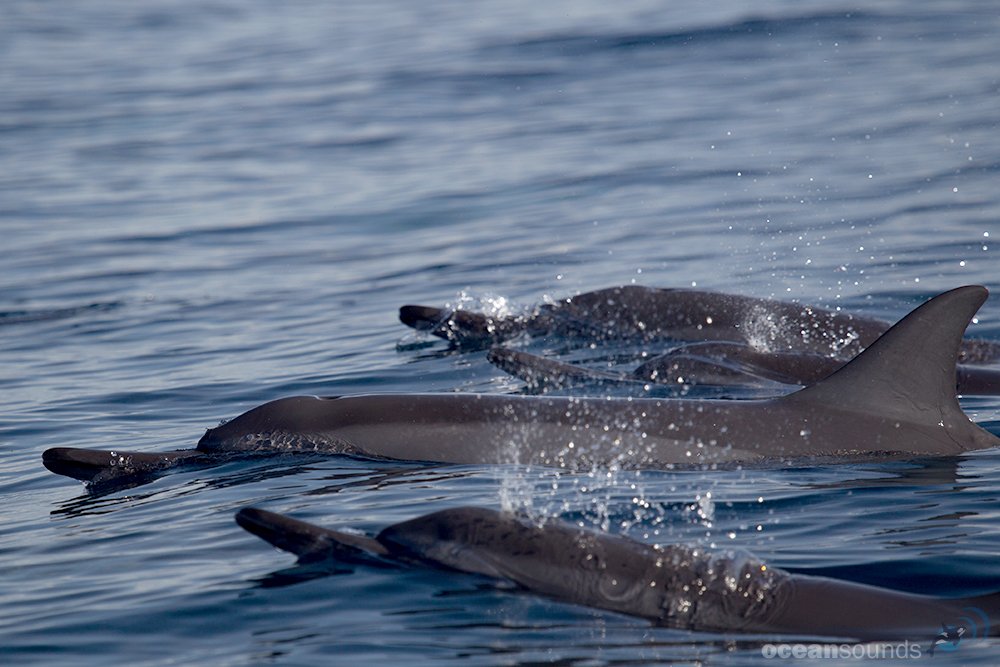
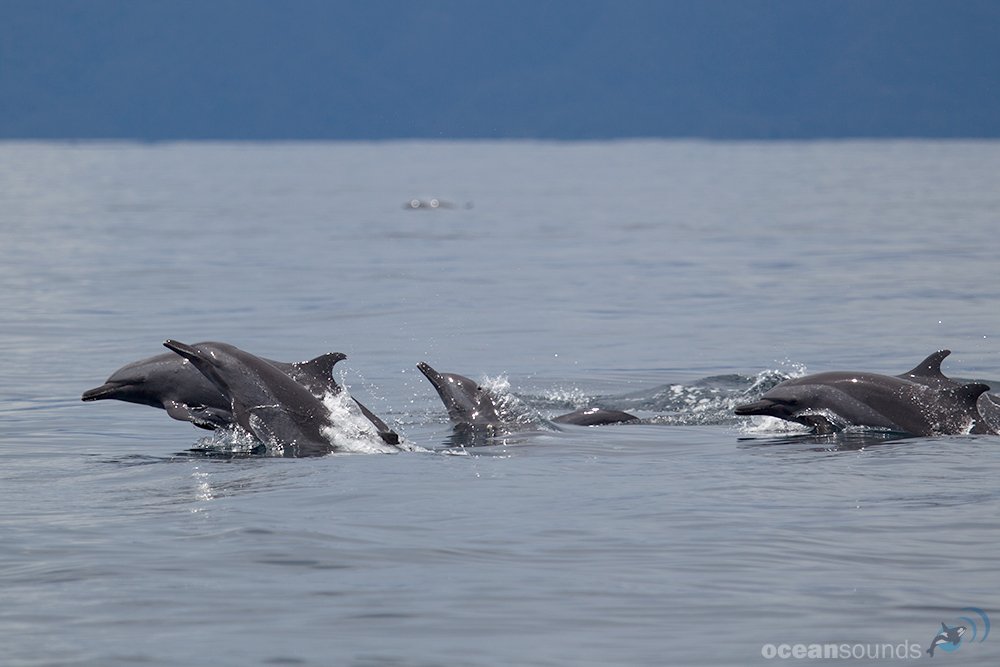
Pantropical spotted dolphin
Stenella attenuata
Raja Ampat: they are common and often sighted in large groups of 100 or more
Group formation: Social fission fusion groups 25-300 (or more)
Size: 2.5 m, calf 80-90 cm
Weight: 120 kg, calf unknown
Age: 40 yrs
Sexual maturity: males 12 yrs, females 10 yrs
Gestation: 11 mths, 2.5-4 yrs in between
Weaning: 1-2 yrs
Diet: mostly small epopelagic fish, squid
Predators: sharks, killer whales, false killer whales, pygmy killer whales, short-finned pilot whales
Distribution: lives in all tropical and subtropical waters between 40° N and 40° S, with 3 sub species, second-most abundant cetacean after the bottlenose dolphin
Population size: > 7 million
Conservation Status: Least Concern ver 3.1, Pop. trend: unknow
Threats: Whaling (Japan, Sri Lanka, Indonesia, Philippines, Taiwan), chemical and plastic pollution, man-made noise impacts (seismic surveys, military sonar), entanglement in fishing gear, as bycatch in yellow tuna fisheries, over fishing, captivity.
Indo-pacific Bottlenose dolphins
Tursiops aduncus
Raja Ampat: they are common and often seen close to shore or in channels
Group formation: Social fission fusion groups 5-20 (sometimes up to 100, mix with bottlenose dolphins)
Size: 2.6 m, calf 80-150 cm
Weight: 230 kg, calf 9-21 kg
Age: >40 yrs
Sexual maturity: males 12 yrs, females 10 yrs
Gestation: 12 mths, 4-6 yrs in between
Weaning: 1-2 yrs
Diet: variety of fish and cephalopods (particularly squid)
Predators: sharks, killer whales, false killer whales, pygmy killer whales, short-finned pilot whales
Distribution: tropical and temperate waters of the Indian and western Pacific Oceans and prefer shallow, nearshore waters
Population size: 6000
Conservation Status: Data Deficient ver 3.1, Pop. trend: unknown
Threats: Whaling (Japan, Sri Lanka, Indonesia, Philippines, Taiwan), chemical and plastic pollution, man-made noise impacts (seismic surveys, military sonar), entanglement in fishing gear, over fishing, captivity
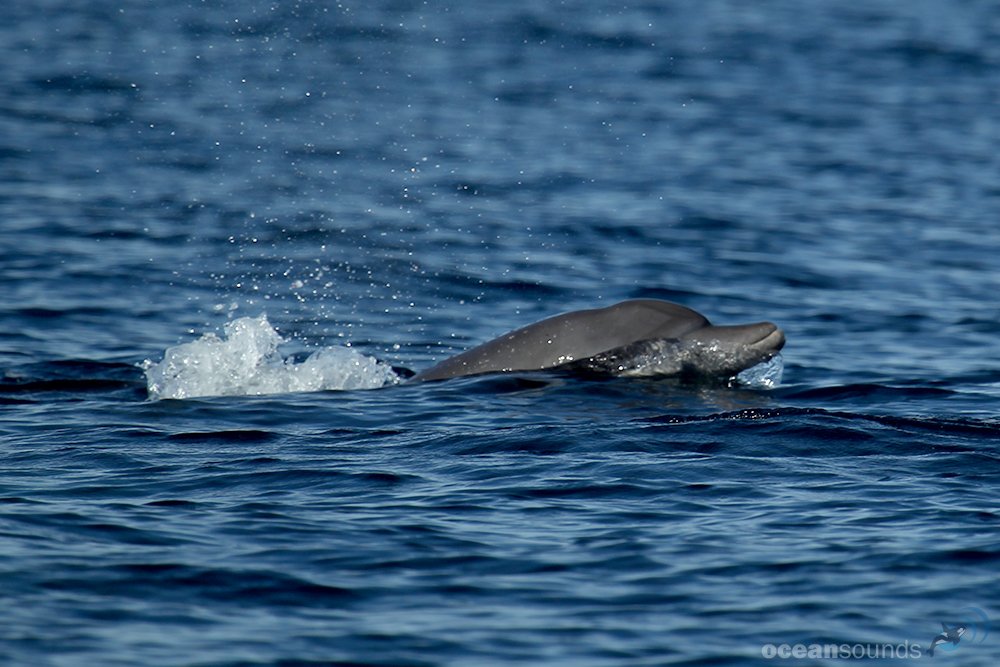

Common Bottlenose dolphin
Tursiops truncatus
Raja Ampat: they are not very common and often seen with short-finned pilot whales
Group formation: Social fission fusion groups 10-30 (sometimes up to 100, mix with other dolphins)
Size: 2-4 m, calf 1.3 m
Weight: 200-600 kg, calf 9-21 kg
Age: 40-50 yrs
Sexual maturity: varies with populations 5-14 yrs
Gestation: 12 mths, 4-6 yrs in between
Weaning: 2.5-3 yrs
Diet: mostly fish, invertebrates, squids
Predators: sharks, killer whales, false killer whales, pygmy killer whales, short-finned pilot whales
Distribution: worldwide distribution ranging 45° N to 45° S, in temperate and tropical waters
Population size: 600.000
Conservation Status: Least Concern ver 3.1, Pop. trend: unknown
Threats: Whaling (Faeroe Islands, Japan, Peru, Ecuador, Chile, Indonesia, Taiwan, Sri Lanka), chemical and plastic pollution, man-made noise impacts (seismic surveys, military sonar), entanglement in fishing gear, bycatch, over fishing, captivity
Fraser’s dolphin
Lagenodelphis hosei
Raja Ampat: not very common, but not much is known
Group formation: Social groups 50-1000
Size: 2-2.75 m, calf 1 m
Weight: 160-210 kg, calf 20 kg
Age: > 20 yrs
Sexual maturity: males 7-10 yrs females 5-8 yrs
Gestation: 12 mths, 2 yrs in between
Weaning: 2.5-3 yrs
Diet: feeds on pelagic fish, squid and shrimp in great depth (200-600 m)
Distribution: Cosmopolitan in deep tropical waters between 30° S and 20° N, common in the Eastern pacific
Population size: 320.000
Conservation Status: Least Concern ver 3.1, Pop. trend: unknown
Threats: Whaling (Japan, Indonesia, Philippines, Sri Lanka, West Indies), chemical and plastic pollution, man-made noise impacts (seismic surveys, military sonar), entanglement in fishing gear, bycatch, over fishing
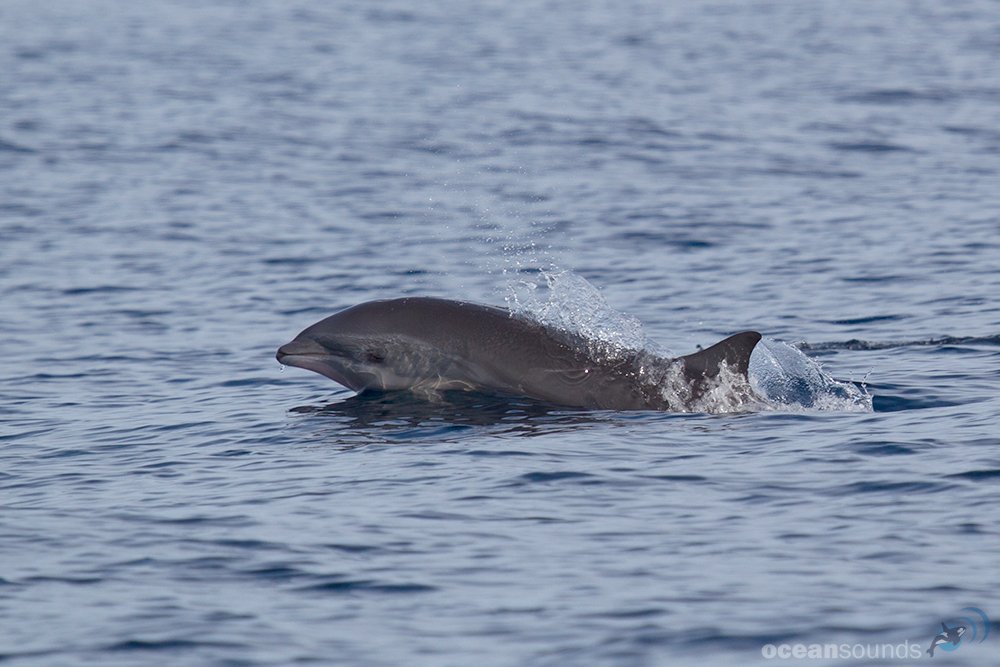
Dugong
Dugong dugon
Raja Ampat: very common, in shallow areas with seagrass, e.g. just outside the resort.
Group formation: solitary (mother calf pair)
Size: 3 m, calf 1.3 m
Weight: 420 kg, calf 30 kg
Age: > 70 yrs
Sexual maturity: 8-18 yrs
Gestation: 13-15 mths, 2.5-7 yrs in between
Weaning: 2.5-3 yrs, stays with mother until mature
Diet: mainly seagrass
Predators: crocodiles, killer whales, sharks pose a threat to the young
Distribution: warm coastal waters from the western Pacific Ocean to the eastern coast of Africa, between 26°N and 27°S
Population size: 320.000
Conservation Status: Vulnerable A2bcd ver 3.1, Pop. trend: unknow
Threats: Vessel collision, Illegal hunting, chemical and plastic pollution, entanglement in fishing gear, over fishing, captivity, habitat loss
Dwarf spinner dolphin
Stenella longirostris roseiventris
Raja Ampat: confirmed sightings
Group formation: social groups
Size: males 127-137 cm
Weight: unknown
Age: unknown
Sexual maturity: unknown
Gestation: unknown
Weaning: unknown
Diet: may feed mostly on benthic fish in reefs and shallow wate
Predators: sharks, killer whales, false killer whales, pygmy killer whales, short-finned pilot whales
Distribution: eastern Pacific, Gulf of Thailand
Population size: unknown
Conservation Status: not listed
Threats: Whaling (Japan, Sri Lanka, Indonesia), chemical and plastic pollution, man-made noise impacts (seismic surveys, military sonar), entanglement in fishing gear, as bycatch in yellow tuna fisheries, over fishing

